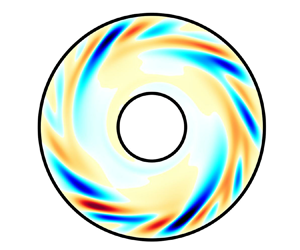Article contents
Effect of radius ratio on the sheared annular centrifugal turbulent convection
Published online by Cambridge University Press: 13 September 2024
Abstract

We perform linear stability analysis and direct numerical simulations to study the effect of the radius ratio on the instability and flow characteristics of the sheared annular centrifugal Rayleigh–Bénard convection, where the cold inner cylinder and the hot outer cylinder rotate with a small angular velocity difference. With the shear enhancement, the thermal convection is suppressed and finally becomes stable for different radius ratios  $\{\eta \in \mathbb {R}|0.2\leqslant \eta \le 0.95\}$. Considering the inhomogeneous distribution of shear stresses in the base flow, a new global Richardson number
$\{\eta \in \mathbb {R}|0.2\leqslant \eta \le 0.95\}$. Considering the inhomogeneous distribution of shear stresses in the base flow, a new global Richardson number  $Ri_g$ is defined and the marginal-state curves for different radius ratios are successfully unified in the parameter domain of
$Ri_g$ is defined and the marginal-state curves for different radius ratios are successfully unified in the parameter domain of  $Ri_g$ and the Rayleigh number
$Ri_g$ and the Rayleigh number  $Ra$. The results are consistent with the marginal-state curve of the wall-sheared classical Rayleigh–Bénard convection in the streamwise direction, demonstrating that the basic stabilization mechanisms are identical. Moreover, systems with small radius ratios exhibit greater geometric asymmetry. On the one hand, this results in a smaller equivalent aspect ratio for the system, accommodating fewer convection roll pairs; fewer roll pairs are more likely to cause a transition in the flow structure during shear enhancement. On the other hand, the shear distribution is more inhomogeneous, allowing for an outward shift of the convection region and the elevation of bulk temperature under strong shear.
$Ra$. The results are consistent with the marginal-state curve of the wall-sheared classical Rayleigh–Bénard convection in the streamwise direction, demonstrating that the basic stabilization mechanisms are identical. Moreover, systems with small radius ratios exhibit greater geometric asymmetry. On the one hand, this results in a smaller equivalent aspect ratio for the system, accommodating fewer convection roll pairs; fewer roll pairs are more likely to cause a transition in the flow structure during shear enhancement. On the other hand, the shear distribution is more inhomogeneous, allowing for an outward shift of the convection region and the elevation of bulk temperature under strong shear.
JFM classification
Information
- Type
- JFM Papers
- Information
- Copyright
- © The Author(s), 2024. Published by Cambridge University Press
References
- 3
- Cited by


